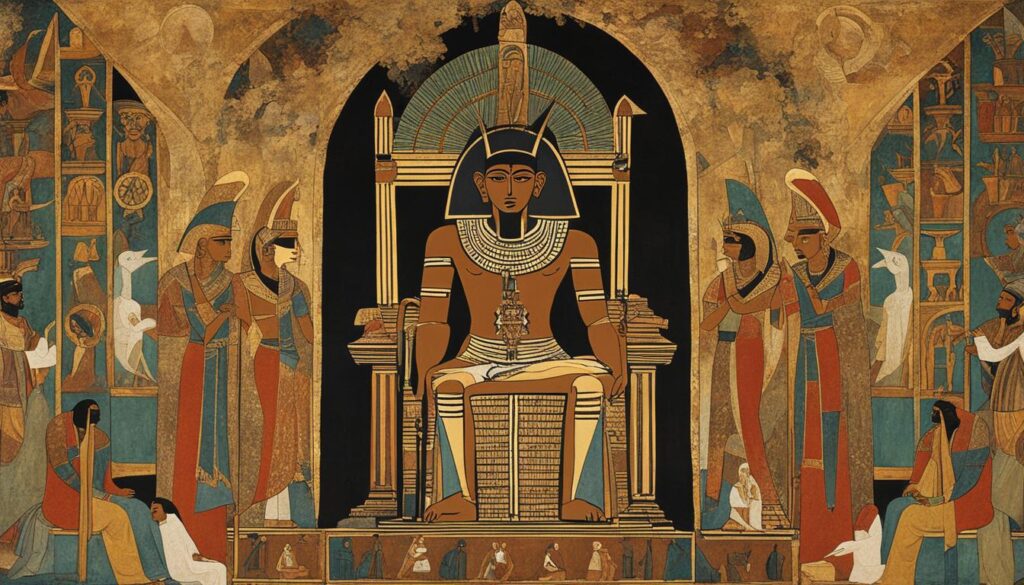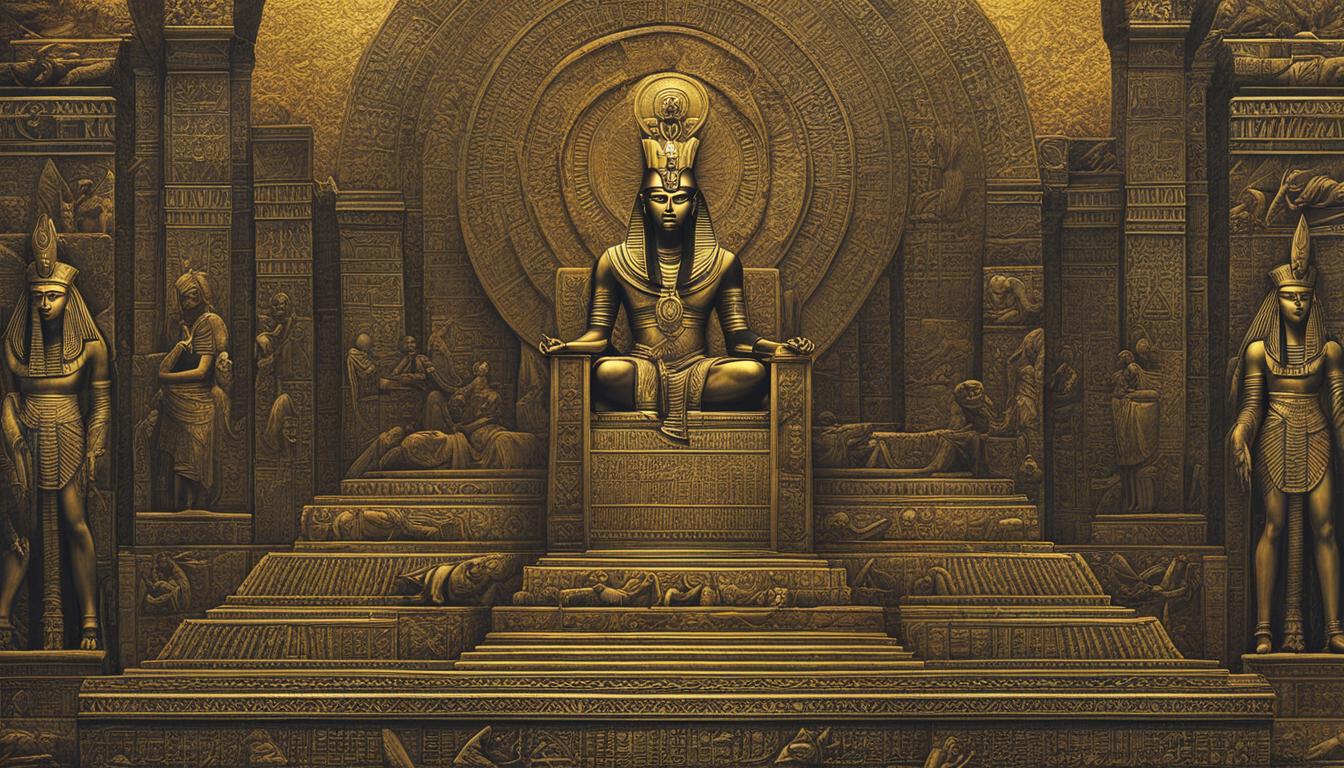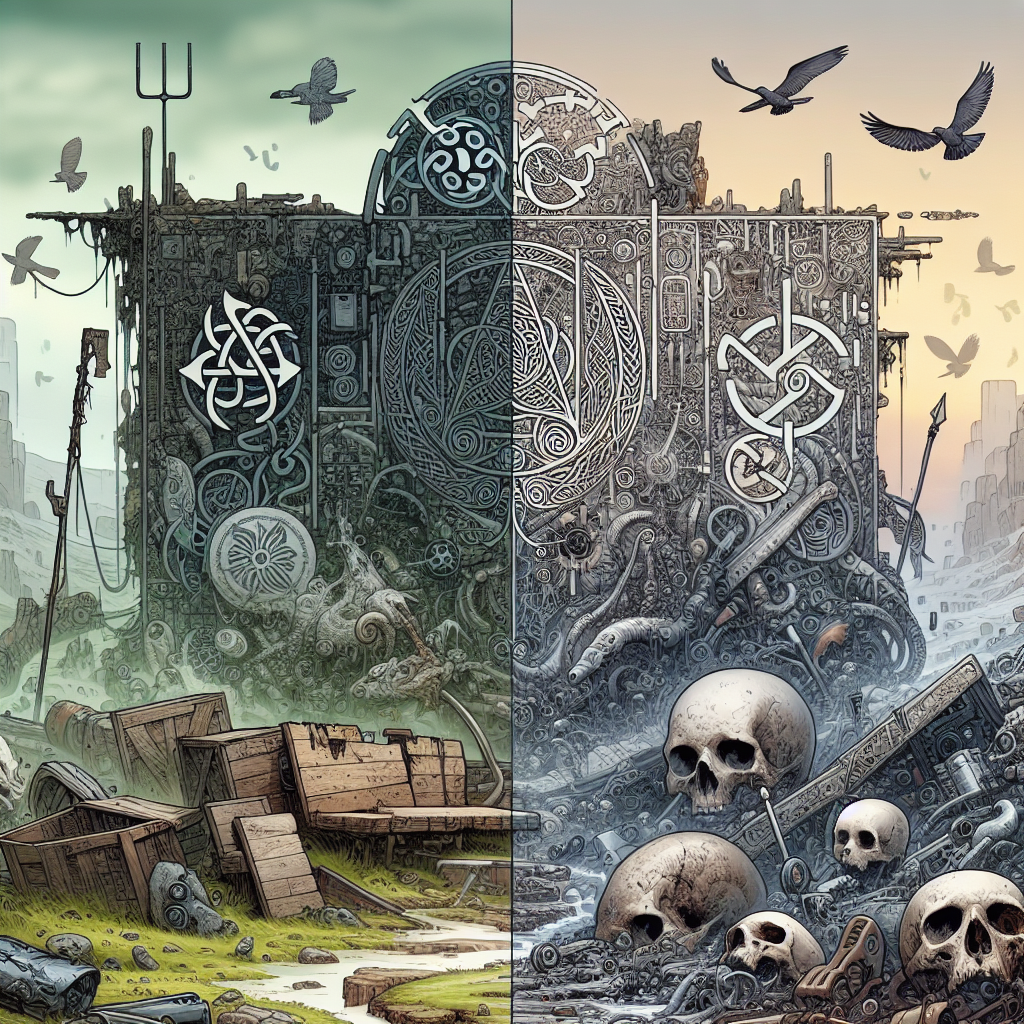The Osiris Judgment and Last Judgment in Christianity are two distinct concepts of judgment in ancient Egyptian mythology and Christian belief, respectively. While Osiris Judgment focuses on the story of Osiris, Isis, Horus, and Set in Egyptian mythology, the Last Judgment in Christianity centers around the final judgment of all souls by God. The differences between these two judgments lie in their religious contexts, theological implications, and cultural significance.
Key Takeaways:
- The Osiris Judgment is based on ancient Egyptian mythology, while the Last Judgment is a concept in Christianity.
- Osiris Judgment revolves around the story of Osiris, Isis, Horus, and Set, while the Last Judgment focuses on the final judgment of all souls by God.
- Religious context, theological implications, and cultural influence differentiate Osiris Judgment and Last Judgment.
- Osiris Judgment influenced Egyptian society and its beliefs, while the Last Judgment has had a global impact through the spread of Christianity.
- Symbolism, rituals, and iconography play significant roles in conveying the narratives of both judgments.
Osiris Judgment in Egyptian Mythology
In ancient Egyptian mythology, the Osiris Judgment holds great significance. Osiris, a central figure in Egyptian religion, was revered as the lord of the underworld, the judge of the dead, and the god of fertility and resurrection. This complex myth revolves around the story of Osiris, the betrayal by his brother Set, his resurrection by his wife Isis, and the birth of their son Horus. The cult of Osiris played a prominent role in ancient Egyptian society, particularly among pharaohs who sought to attain immortality by aligning themselves with the god.
The Osiris myth centers on the idea of death, rebirth, and the afterlife. Osiris’s role as the judge of the dead highlights the importance of judgment and the belief in an afterlife in Egyptian culture. It reflects the Egyptians’ desire for personal immortality and their understanding of the cycle of life. The myth also emphasizes the power of love, loyalty, and family bonds, as seen in Isis’s devotion to resurrecting Osiris and the birth of Horus, who avenges his father’s death.
To visually engage with the Osiris myth, a table can be created to highlight key elements of the story and their significance:
| Mythological Element | Significance |
|---|---|
| Osiris as lord of the underworld | Represents the Egyptian concept of the afterlife and the realm of the dead |
| Osiris as judge of the dead | Reflects the belief in divine judgment and the determination of one’s fate in the afterlife |
| Osiris as god of fertility and resurrection | Symbolizes the cyclical nature of life and death, as well as the hope for rebirth and renewal |
| Betrayal of Osiris by Set | Represents the struggle between order and chaos, righteousness and evil |
| Resurrection of Osiris by Isis | Symbolizes the power of love, devotion, and the pursuit of immortality |
| Birth of Horus | Reflects the continuation of divine lineage and the restoration of balance and order |
| Cult of Osiris in ancient Egypt | Highlights the worship and veneration of Osiris, particularly among the pharaohs |
By examining these elements, we can gain a deeper understanding of the cultural and religious significance of the Osiris Judgment in Egyptian mythology.
Last Judgment in Christianity
In Christianity, the Last Judgment is believed to be a future event where all souls will be judged by God. It is associated with the Second Coming of Jesus Christ, the central figure in Christian theology. The Last Judgment holds great theological significance as it represents the final judgment of all human beings, determining their eternal destinies. According to Christian belief, the dead will be resurrected, and all souls, both the saved and the damned, will stand before God to be judged.
The Last Judgment is a complex concept that encompasses several key elements. It involves the resurrection of the dead, where the physical bodies of the deceased are raised to be reunited with their souls. It also includes the separation of the saved and the damned, with the righteous being granted eternal life in heaven and the unrepentant sinners facing eternal punishment in hell. This representation of heaven and hell in the context of the Last Judgment is a powerful symbol of the eternal consequences of one’s actions and choices in life.
One of the most iconic depictions of the Last Judgment is found in Michelangelo’s fresco in the Sistine Chapel. Completed in the early 16th century, this masterpiece showcases the biblical narrative of the Last Judgment, with Jesus Christ as the central figure, surrounded by angels, saints, and the resurrected dead. The fresco captures the intensity and drama of this apocalyptic event, evoking a sense of awe and reverence.
Similarities Between Osiris Judgment and Last Judgment
The Osiris Judgment and the Last Judgment in Christianity share several striking similarities, despite their distinct religious contexts. A comparison between Osiris and Jesus reveals parallels in their roles as shepherds. Both Osiris and Jesus were betrayed by those close to them, leading to their painful deaths. The symbolism associated with these figures, such as the Djed (in the case of Osiris) and the Cross (in Christianity), carries similar meaning as representations of sacrifice and redemption.
Furthermore, both Osiris and Jesus experienced resurrection after their deaths, solidifying their positions as divine rulers in the afterlife. Osiris became the lord of the underworld, while Jesus ascended to become the king of heaven. Additionally, both figures serve as judges in their respective belief systems, with Osiris presiding over the judgment of the dead and God overseeing the Last Judgment.
To summarize, key similarities between the Osiris Judgment and the Last Judgment include the role of Osiris and Jesus as shepherds, their betrayal and painful deaths, the presence of symbolic representations, their resurrections, their positions as rulers in the afterlife, and their roles as judges in the final judgment of souls.
Historical and Cultural Significance
The Osiris Judgment and the Last Judgment hold immense historical and cultural significance in their respective religious contexts. The Osiris myth, originating in ancient Egypt, had a profound impact on Egyptian society for thousands of years. It shaped religious rituals, beliefs, and influenced other cultures’ perspectives on death, resurrection, and the afterlife. The story of Osiris, Isis, and Horus resonated globally, illustrating the human fascination with immortality and the cyclical nature of life.
Similarly, the Last Judgment in Christianity has had a global influence over the course of two millennia. As one of the central beliefs in Christian theology, the Last Judgment showcases the consequences of one’s actions and the ultimate fate of all souls. It has shaped religious practices, artistic representations, and has left an indelible mark on the development of global cultures impacted by Christianity.
Rituals and beliefs surrounding the Osiris Judgment and the Last Judgment in Christianity have provided a framework for individuals to contemplate mortality, redemption, and the concept of divine judgment. These religious practices reflect the values, hopes, and fears of their respective cultures, offering insights into the human understanding of life’s ultimate questions. The historical and cultural significance of both judgments underscores the enduring power of religious narratives in shaping societies and influencing individuals’ spiritual beliefs.
| Historical Significance | Cultural Significance |
|---|---|
| The Osiris Judgment shaped Egyptian religious rituals and beliefs for millennia. | The Osiris myth influenced art, literature, and symbolism in ancient Egypt and beyond. |
| The Last Judgment is a central belief in Christian theology with a global impact. | The Last Judgment influenced art, literature, and religious practices worldwide. |
| The Osiris Judgment reflects the Egyptian understanding of life, death, and the afterlife. | The Osiris myth resonated with cultures worldwide, shaping perspectives on immortality and rebirth. |
| The Last Judgment showcases the consequences of actions and the fate of all souls. | The Last Judgment influenced cultural development in regions impacted by Christianity. |
Differences in Religious Context
One of the core distinctions between the Osiris Judgment and the Last Judgment lies in their religious contexts. The Osiris Judgment originated from ancient Egyptian polytheistic beliefs, where Osiris was part of a pantheon of gods worshipped by the Egyptians. In contrast, the Last Judgment is rooted in Christian monotheism, with God as the supreme being and the sole object of worship.
Osiris, in Egyptian mythology, held a prominent place among the gods, and his role encompassed judging souls in the afterlife, as well as being the lord of the underworld and the god of fertility and resurrection. However, Christianity developed the concept of the Last Judgment by incorporating ancient beliefs, cultural practices, and religious teachings into its emerging theology. This transition marked a shift from the worship of multiple gods to the worship of a single deity and brought forth distinct eschatological beliefs concerning the final judgment of all souls.
The differences in religious context between the Osiris Judgment and the Last Judgment reflect the contrasting religious traditions from which they originated and the unique theological frameworks in which they are situated.

Table: Comparative Overview of Religious Context
| Osiris Judgment | Last Judgment |
|---|---|
| Ancient Egyptian polytheistic beliefs | Christian monotheism |
| Osiris as part of Egyptian pantheon | God as the supreme being |
| Worship of multiple gods | Worship of a single deity |
| Focus on Egyptian mythological figures | Focus on Jesus Christ as the central figure |
| Associated with fertility, resurrection, and the underworld | Associated with salvation, resurrection, and eternal life |
Theological Implications
The Osiris Judgment and the Last Judgment carry distinct theological implications, reflecting the conceptions of the afterlife, the role of judgment in salvation, and the concepts of immortality within their respective belief systems.
In the Osiris Judgment, the judgment of souls serves a crucial purpose in determining one’s afterlife. Osiris, as the judge, holds the key to immortality, and individuals’ fates are decided based on their actions and adherence to Ma’at, the concept of cosmic order. The mythic cycle of Osiris’s death and resurrection represents the Egyptian yearning for personal immortality and the continuous cycle of life and death.
In contrast, the Last Judgment in Christianity is closely tied to the concept of salvation. Individuals are judged based on their belief in Jesus Christ and their actions in accordance with Christian teachings. Salvation is attainable through faith and good deeds, and the Last Judgment represents the culmination of God’s divine justice, granting eternal life to the righteous and condemning the wicked.
Concepts of the Afterlife
The conceptions of the afterlife in the Osiris Judgment and the Last Judgment differ significantly. In the Osiris Judgment, the afterlife is believed to be a continuation of earthly existence, where individuals undergo judgment and are rewarded or punished based on their moral conduct. The goal is to achieve eternal life and be united with Osiris in the realm of the dead.
On the other hand, the Last Judgment in Christianity introduces the concept of an eternal, unchanging afterlife. The righteous are promised a heavenly existence in the presence of God, while the unrepentant sinners face eternal damnation in hell. The Last Judgment represents the final separation of the saved and the damned, with profound implications for the eternal destiny of souls.
Role of Judgment in Salvation
Both the Osiris Judgment and the Last Judgment highlight the role of judgment in the salvation of individuals. In the Osiris Judgment, the judgment of souls determines one’s fate in the afterlife, with Osiris serving as the arbiter of justice. The judgment is based on the individual’s moral conduct and adherence to Ma’at, emphasizing the importance of righteousness and ethical behavior.
In Christianity, the Last Judgment is the ultimate verdict on one’s faith and actions. The judgment is based on the individual’s belief in Jesus Christ as the savior and their efforts to live according to Christian teachings. Good deeds and acts of compassion are seen as evidence of genuine faith and are rewarded in the final judgment.
Concepts of Immortality
The Osiris Judgment and the Last Judgment also differ in their concepts of immortality. In the Osiris Judgment, immortality is achieved through identification with Osiris and the continuous cycle of life, death, and rebirth. The story of Osiris’s resurrection symbolizes the promise of eternal life for all souls, with the goal of being united with Osiris in the afterlife.
In Christianity, immortality is attained through belief in Jesus Christ and the promise of eternal life in heaven. The Last Judgment signifies the fulfillment of this promise, where the righteous are granted immortality and eternal bliss in the presence of God. The concept of immortality in Christianity emphasizes the significance of faith and salvation through Jesus Christ.
| Theological Implications | Osiris Judgment | Last Judgment |
|---|---|---|
| Conceptions of the Afterlife | A continuation of earthly existence, achieving eternal life through judgment and union with Osiris in the realm of the dead | An eternal, unchanging afterlife with rewards for the righteous and punishment for the unrepentant sinners |
| Role of Judgment in Salvation | Determines one’s fate in the afterlife based on moral conduct and adherence to Ma’at | Verdict on one’s faith and actions, with salvation attained through belief in Jesus Christ and living according to Christian teachings |
| Concepts of Immortality | Achieved through identification with Osiris and the cycle of life, death, and rebirth | Attained through belief in Jesus Christ, with the promise of eternal life in heaven |
Cultural Influences and Evolution of Representations
The Osiris Judgment and the Last Judgment have had a profound impact on art, literature, symbolism, and religious practices throughout history. The Osiris myth, with its themes of death, resurrection, and the afterlife, inspired a rich artistic tradition in ancient Egypt. Artists depicted scenes from the Osiris myth on temple walls, tomb paintings, and funerary objects, conveying the hope for personal immortality and the cyclical nature of life. The Djed symbol, representing Osiris’s power and fertility, frequently appeared in these artistic representations, symbolizing the eternal renewal of life.
Similarly, the Last Judgment in Christianity has left a lasting imprint on artistic and cultural expressions. The judgment scene, with its representation of heaven and hell, served as a source of inspiration for countless artists throughout the centuries. Michelangelo’s iconic fresco in the Sistine Chapel is a prime example, depicting the dramatic scene of judgment and the contrast between the saved and the damned. This masterpiece not only showcased the artist’s talent but also conveyed the theological significance and moral implications of the Last Judgment.
Moreover, both the Osiris Judgment and the Last Judgment have found their way into popular culture. References and allusions to these judgments can be found in literature, films, and music. For example, the concepts of resurrection, judgment, and the struggle between good and evil, influenced by the Osiris myth and the Last Judgment, have been incorporated into numerous fantasy and science fiction novels. The enduring themes and symbolism of these judgments continue to captivate and inspire audiences worldwide.
| Artistic Influences | Cultural Influences |
|---|---|
|
|
| Evolution of Representations | Popular Culture References |
|
|
Symbolism and Iconography
The Osiris myth and the Last Judgment employ rich symbolism and intricate iconography to convey their respective religious narratives. In the Osiris myth, one of the prominent symbols is the Djed symbol, which is reminiscent of a cruciform shape. This symbolizes Osiris’s divine power over fertility, resurrection, and the perpetual cycle of life and death. The Djed serves as a powerful reminder of the Egyptian yearning for personal immortality and the mythic cycle of life, death, and rebirth.
In Christianity, the Cross stands as a significant symbol, representing the ultimate sacrifice of Jesus Christ and his triumph over death. The Cross symbolizes redemption, salvation, and the unfathomable love of God. It is a powerful emblem that encapsulates the core beliefs of Christianity and serves as a potent reminder of the faithful’s commitment to their faith.
The iconography of Osiris and the Last Judgment plays a pivotal role in visually conveying their stories and religious teachings. In depictions of Osiris, he is often portrayed with a regal appearance, adorned with the symbols of power and fertility. These visual representations reflect his status as the lord of the underworld, the judge of souls, and the bringer of fertility and resurrection.
Similarly, the iconography of the Last Judgment captures the dramatic and transformative nature of this divine event. Artistic representations often depict Jesus Christ as the central figure, surrounded by angels and souls awaiting judgment. These powerful visual depictions communicate the gravity and magnitude of the final judgment, illustrating the eternal consequences of one’s actions and beliefs.
Table: Symbolism in Osiris Myth and Last Judgment
| Symbol | Osiris Myth | Last Judgment |
|---|---|---|
| Djed Symbol | Represents Osiris’s power over fertility, resurrection, and the renewal of life. | N/A |
| Cross Symbol | N/A | Symbolizes the sacrifice of Jesus Christ, redemption, and salvation. |
The symbolism and iconography of the Osiris myth and the Last Judgment serve as profound visual representations of their respective religious narratives. Through these symbols and images, believers are reminded of the fundamental concepts and teachings that underlie these ancient myths and religious beliefs.
Cultural Dialogue and Interconnections
The Osiris myth and the Last Judgment provide a fascinating basis for cultural dialogue and exploration of interconnections between different belief systems. Throughout history, there have been instances of adaptation and syncretism of religious themes, resulting in the interplay of ancient Egyptian beliefs and Christianity. This cross-pollination of ideas and beliefs has had a profound impact on the development of religious narratives and practices.
A notable influence of ancient Egyptian mythology on Christian theology can be seen in the incorporation of certain motifs and symbols. The concept of judgment and the afterlife found in the Osiris myth have contributed to the theological framework surrounding the Last Judgment in Christianity. Ancient Egyptian beliefs surrounding immortality, resurrection, and the role of a divine judge have influenced Christian teachings on salvation, the redemption of souls, and the ultimate judgment by God.
A comparative study of the Osiris myth and the Last Judgment sheds light on the similarities and differences between these two belief systems. It invites us to examine the cultural and theological nuances that shaped these narratives and the ways in which they continue to resonate with individuals and communities today. By engaging in this comparative exploration, we gain a deeper understanding of the complexities of religious beliefs and their enduring significance throughout human history.
| Osiris Myth | Last Judgment in Christianity |
|---|---|
| Centers around Osiris, Isis, and Horus | Focuses on the final judgment of all souls by God |
| Explores concepts of fertility, resurrection, and the afterlife | Involves the resurrection of the dead and the separation of the saved and the damned |
| Shows the judgment of souls by Osiris | Highlights God’s judgment of all souls based on their faith and actions |
| Reflects ancient Egyptian polytheistic beliefs | Rooted in Christian monotheism |
Conclusion
The Osiris Judgment and the Last Judgment in Christianity represent two distinct belief systems that hold significant historical, cultural, and theological significance. While the Osiris Judgment originates from ancient Egyptian mythology and centers around the story of Osiris, Isis, and Horus, the Last Judgment is a core concept in Christian belief, focusing on the final judgment of all souls by God. These judgments possess core distinctions that stem from their religious contexts, theological implications, and cultural influences.
The differences between the Osiris Judgment and the Last Judgment are fundamental and shape the understanding of religious history. The Osiris Judgment reflects the polytheistic beliefs of ancient Egypt, revolving around a pantheon of gods, with Osiris playing a prominent role as the judge of souls and the lord of the underworld. In contrast, the Last Judgment is rooted in Christian monotheism, emphasizing the belief in one supreme being, God, who judges all souls based on their faith and actions.
Appreciating the complexities and diversity of religious beliefs is crucial in understanding the significance of the Osiris Judgment and the Last Judgment. These beliefs provide insights into the human quest for meaning, mortality, and the concept of divine judgment. The Osiris Judgment and the Last Judgment hold immense value in religious history, shaping cultural practices, artistic representations, and offering guidance on morality, redemption, and the pursuit of eternal life.
In conclusion, the Osiris Judgment and the Last Judgment are distinct in their religious contexts, theological implications, and cultural influences. While both judgments share some similarities, such as the symbolism of shepherds, betrayal, and resurrection, they reflect the unique belief systems and provide valuable insights into the complexities and diversity of religious beliefs throughout history.
FAQ
What is the difference between Osiris Judgment and Last Judgment in Christianity?
The Osiris Judgment is a concept in ancient Egyptian mythology, while the Last Judgment is a belief in Christianity.
What is the Osiris Judgment in Egyptian mythology?
The Osiris Judgment revolves around the story of Osiris, Isis, Horus, and Set. It focuses on Osiris as the judge of souls in the afterlife.
What is the Last Judgment in Christianity?
The Last Judgment is a future event in Christian belief where all souls will be judged by God. It is associated with the Second Coming of Jesus Christ.
Are there any similarities between the Osiris Judgment and the Last Judgment?
Yes, both Osiris and Jesus are associated with the role of shepherds to their followers. They both experienced betrayal and resurrection, and they both perform judgment.
What is the historical and cultural significance of the Osiris Judgment and the Last Judgment?
The Osiris myth had a profound impact on Egyptian society and influenced their religious rituals and beliefs. The Last Judgment in Christianity has spread over two thousand years and has had a significant influence on art, literature, and religious practices.
What are the differences in religious context between the Osiris Judgment and the Last Judgment?
The Osiris Judgment originated from ancient Egyptian polytheistic beliefs, while the Last Judgment is rooted in Christian monotheism.
What are the theological implications of the Osiris Judgment and the Last Judgment?
In the Osiris Judgment, the judgment of souls determines one’s afterlife and reflects the Egyptian yearning for personal immortality. In Christianity, the Last Judgment is closely tied to the concept of salvation and the granting of eternal life.
How have the Osiris Judgment and the Last Judgment influenced culture?
The Osiris myth inspired artwork, literature, and symbolism in ancient Egypt. The Last Judgment has influenced art, literature, and religious practices, with representations of the judgment scene and depictions of heaven and hell.
How do symbolism and iconography play a role in the Osiris Judgment and the Last Judgment?
In the Osiris myth, the Djed symbol represents Osiris’s power over fertility, resurrection, and the renewal of life. In Christianity, the Cross symbolizes the sacrifice of Jesus Christ and represents redemption and salvation.
What is the significance of cultural dialogue and interconnections between the Osiris myth and the Last Judgment?
The adaptation and syncretism of religious themes are evident in the influences of ancient Egyptian mythology on Christian theology. Comparative studies shed light on the similarities and differences between these two belief systems.
What are the core distinctions between the Osiris Judgment and the Last Judgment?
The Osiris Judgment and the Last Judgment have different religious contexts and theological implications. They serve unique purposes within their respective cultures and belief systems.
 Skip to main content
Skip to main content


